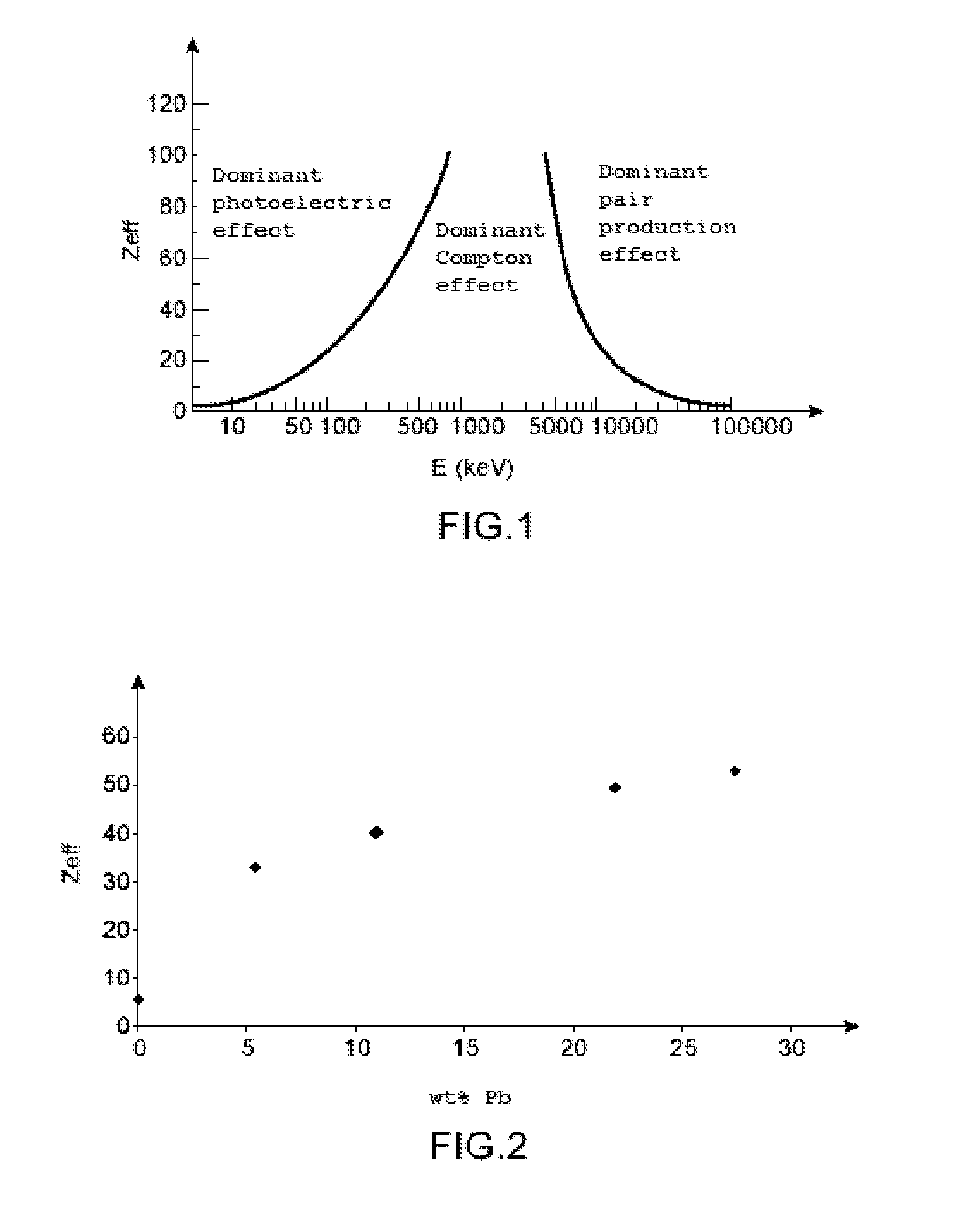Solid organic scintillator doped by one or more chemical elements
a technology of organic scintillators and chemical elements, applied in the direction of conversion screens, nuclear engineering, luminescent compositions, etc., can solve the problems of poor quality, little useful for x-imaging, and x-ray images obtained with materials
- Summary
- Abstract
- Description
- Claims
- Application Information
AI Technical Summary
Benefits of technology
Problems solved by technology
Method used
Image
Examples
example 1
Preparation of a Scintillator Conforming to the Invention
[0123]The scintillator conforming to the invention prepared according to this Example comprises a polymeric matrix formed of a poly(vinyltoluene-co-methacrylic acid) copolymer cross-linked with lead dimethacrylate, in which a first fluorophore compound is dispersed: N-(2′,5′-di-t-butylphenyl)-4-butylamino-1,8-naphthalimide of following formula (II):
[0124]and a second fluorophore compound: (bis-N-( 2,5-di-t-butylphenyl)-3,4,9,10-perylenetetracarbodiimide) of following formula (IV):
[0125]Initially, preparation of the first fluorophore compound is performed after which the scintillator as such is prepared.
[0126]The second fluorophore compound is commercially available.
a) Preparation of N-(2′,5′-di-t-butylphenyl)-4-butylamino-1,8-naphthalimide
[0127]The title compound is prepared as per the following reaction scheme:
Ac meaning acetyl and NMP meaning N-methylpyrrolidone.
[0128]Compounds 1 and 2 are commercially available.
*Synthesis o...
example 2
Preparation of Another Scintillator Conforming to the Invention
[0147]The scintillator conforming to the invention prepared in this Example comprises a polymeric matrix formed of a poly(2-hydroxyethyl methacrylate) polymer cross-linked with lead dimethacrylate, in which are dispersed a first fluorophore compound: N-(2′,5′-di-t-butylphenyl)-4-butylamino-1,8-naphthalimide of following formula (II):
[0148]and a second fluorophore compound: (bis-N-( 2,5-di-t-butylphenyl)-3,4,9,10-perylenetetracarbodiimide) of following formula:
[0149]The first fluorophore compound is prepared following the operating protocol described in Example 1.
[0150]The second fluorophore compound is commercially available.
[0151]The scintillator as such is prepared as per the following operating protocol.
[0152]Pure 2-hydroxyethyl methacrylate (5 g, 38.4 mmol), lead dimethacrylate (5 g, 13.2 mmol), N-( 2′,5′-di-t-butylphenyl)-4-butylamino-1,8-naphthalimide (5 mg, 0.011 mmol) and bis-N-(2,5-di-t-butylphenyl)-3,4,9,10-per...
example 3
[0163]The scintillator conforming to the invention prepared in accordance with this Example comprises a polymeric matrix comprising a poly(vinyltoluene-co-methacrylic acid) copolymer cross-linked with n-dibutyltin dimethacrylate in which are dispersed a first fluorophore compound: N-(2′,5′-di-t-butylphenyl)-4-butylamino-1,8-naphthalimide of following formula (II):
[0164]and a second fluorophore compound: (bis-N-( 2,5-di-t-butylphenyl)-3,4,9,10-perylenetetracarbodiimide) of following formula (IV):
[0165]Initially the first fluorophore compound is prepared followed by the preparation of the scintillator as such.
[0166]The second fluorophore compound is commercially available.
[0167]The scintillator as such is prepared as per the following operating protocol.
[0168]Pure methacrylic acid (2.525 g, 29.3 mmol), pure vinyltoluene (2.525 g, 21.4 mmol), n-dibutyltin dimethacrylate (3.367 g, 8.3 mmol), N-(2′,5′-di-t-butylphenyl)-4-butylamino-1,8-naphthalimide (4.2 mg, 0.01 mmol) and bis-N-(2,5-di-...
PUM
 Login to View More
Login to View More Abstract
Description
Claims
Application Information
 Login to View More
Login to View More - R&D
- Intellectual Property
- Life Sciences
- Materials
- Tech Scout
- Unparalleled Data Quality
- Higher Quality Content
- 60% Fewer Hallucinations
Browse by: Latest US Patents, China's latest patents, Technical Efficacy Thesaurus, Application Domain, Technology Topic, Popular Technical Reports.
© 2025 PatSnap. All rights reserved.Legal|Privacy policy|Modern Slavery Act Transparency Statement|Sitemap|About US| Contact US: help@patsnap.com



